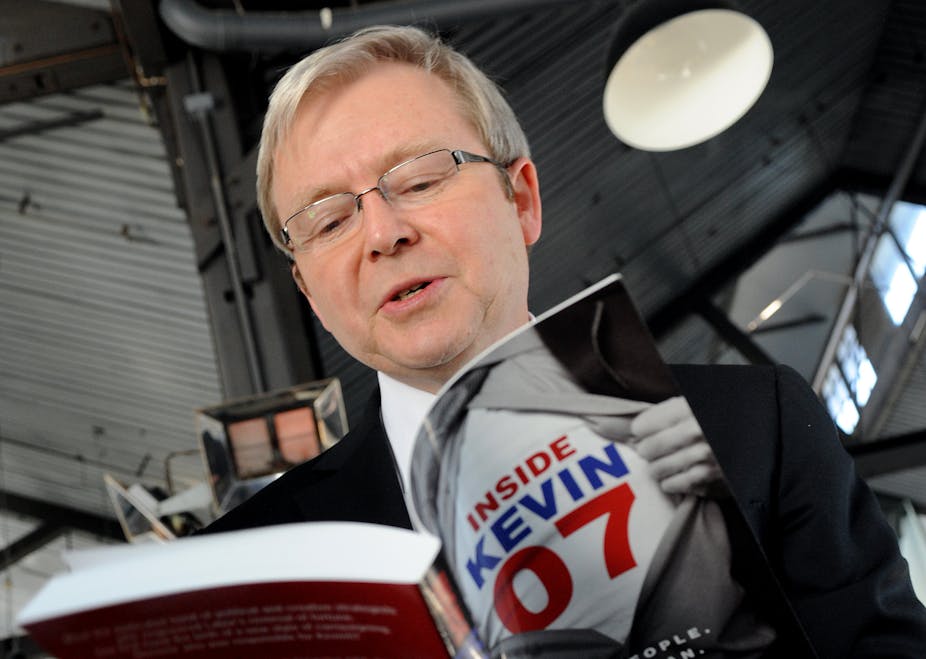Arriving back in Australia on Friday, Kevin Rudd said, “If you have a strong view on the future prime ministership of the country, your power as the people is what will count.”
In response to Rudd’s call for “people power”, ALP backbencher Michael Danby said, “He is a mortal political like the rest of us and I hope the Australian people, when they’re ringing offices and using these Tea Party tactics to … win office, have a more realistic view.”
Danby’s observation regarding “Tea Party politics” is an interesting one, because it points to a key problem that plagues both Gillard and Rudd – what US psephologists (election experts) call the “enthusiasm gap”.
Gillard is suffering from an enthusiasm gap in the electorate and Rudd is suffering from an enthusiasm gap among his parliamentary colleagues.
It came as no surprise that Gillard got the nod this morning, but she still struggles with her popularity among the Australian public. Rudd has the public vote, but clearly not that of the Labor caucus.
Lessons from the US
The concept of an enthusiasm gap is used primarily to refer to differing levels of predicted and actual turnout of voters on election days.
Voting is compulsory in Australia, so we do not have the same problem of “voter mobilisation” as in the US where voting is not compulsory, but it does manifest in other ways.
A preliminary analysis of the concept of an enthusiasm gap in print-based US political journalism has indicated a number of different uses. These include:
Differences in levels of voter support across demographic segments. An early use of the phrase in 1996 indicated there had been a shift amongst conservative voters relative to progressives from a “gender gap” to an enthusiasm gap in presidential election voter turnout rates.
Differences in the composition of campaign funding. Observers pointed out that even though Hillary Clinton and Obama had roughly similar levels of campaign funds during the 2007 Democratic presidential nomination race ($25m vs $32m respectively), they had different compositions of numbers of donations and dollar amount of the donations. Obama had a large number of donations of a small dollar amount, while Clinton had fewer donations, but these were of larger dollar amounts.
Using the media to modulate voter enthusiasm. The addition of Sarah Palin to the 2008 presidential race and in particular her performance at the Republican National Convention was reported to have closed the enthusiasm gap Obama had over his Republican competition. Traditional strategic communication tools such as “narrative” are important here, with Obama’s “Hope” political narrative seen as far superior to John McCain’s anaemic Republican narratives of beaing the “maverick,” the “reformer,” the “war hero,” and the “bipartisan negotiator.”
The importance of direct action groups in activating and cultivating voter enthusiasm. The Tea Party was understood to fuel the Republican edge in mid-term election enthusiasm with 74% of Tea Party supporters enthusiastic about voting. This was compared to 43% of Democrats and 57% of Republicans.
The asymmetrical growth and decline of enthusiasm between parties and/or candidates. An “enthusiasm gap” can be produced by increasing enthusiasm in a candidate or the candidate’s opposition losing enthusiasm. Republicans are currently discussing how they believe Obama cannot replicate the “magic” of 2008 to ward off anxieties over voter turnout in the current Republican presidential nomination race.

Kevin 07 is dead
In Australia, the last three points are relevant for understanding support for parties, politicians and policies in the electorate. Funding is certainly important, but in Australia this is more of a diagnostic point than a causal one and therefore less important when assessing the political enthusiasm in the electorate. Arguably, Rudd’s comments regarding “people power” invoked the enthusiasm gap that worked in his favour during his 2007 election.
But the enthusiasm gap of “Kevin 07” over Howard’s Coalition was not made only by Kevin Rudd. The gap in the 2007 election was a product of not just the “Kevin 07” narrative, but also the catalysing effect of direct action groups (Getup, unions, and so on), and electorate dissatisfaction with Howard’s Coalition government.
However important Kevin Rudd was to the 2007 election result, these conditions will not be repeated in any future election. Dissatisfaction is currently with the ALP government and direct action groups have mobilised against, not for, ALP policy in the form of opposition to the mining tax, pokie reform and the price on carbon.
No going back for Labor
Labor will have a serious problem regardless of the result of this morning’s leadership spill.
This much is obvious to most political commentators. Indeed, the Labor leadership stoush was a classic example of a political party acting in such a way as to lose enthusiasm, rather than the opposition political party working to produce it.

